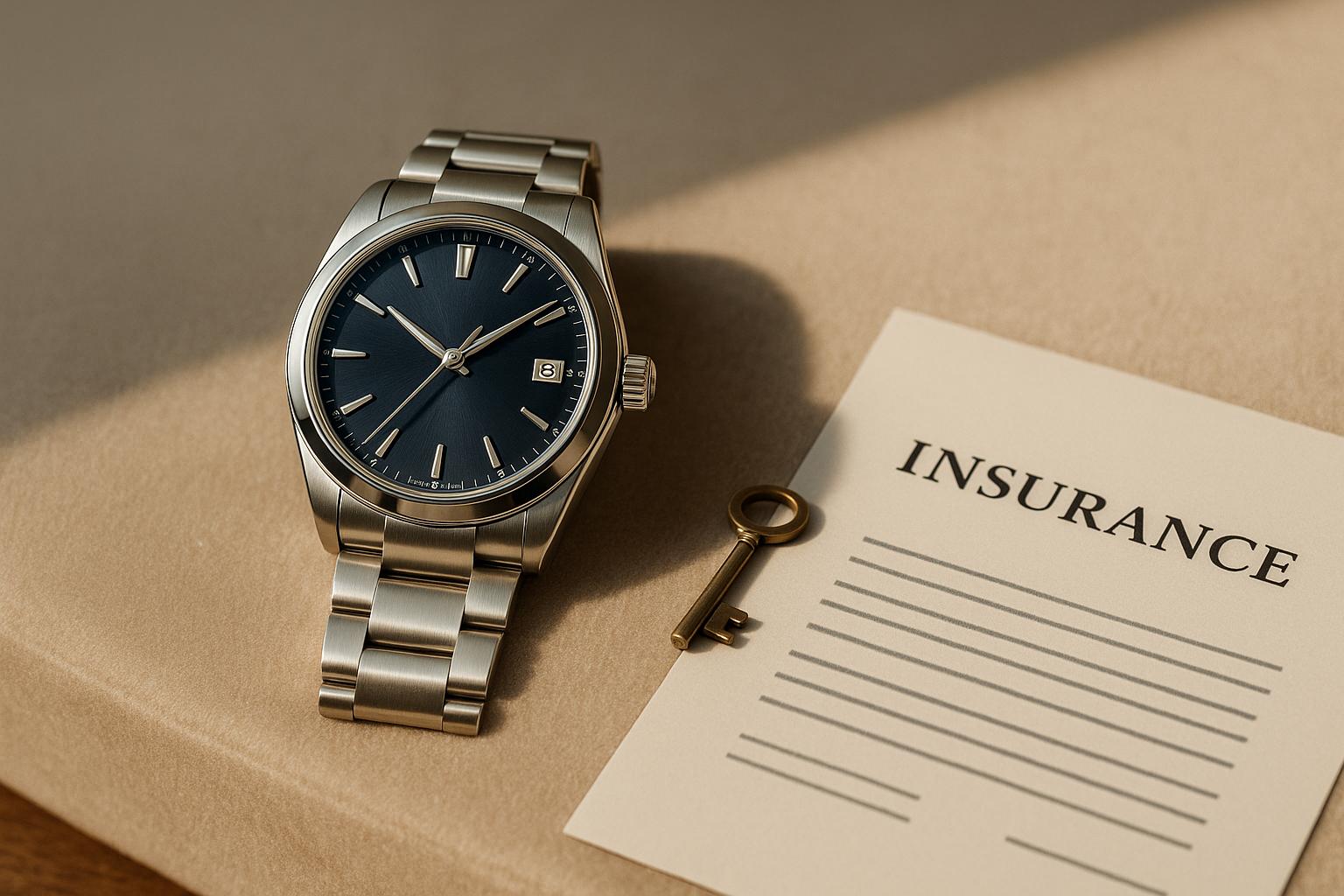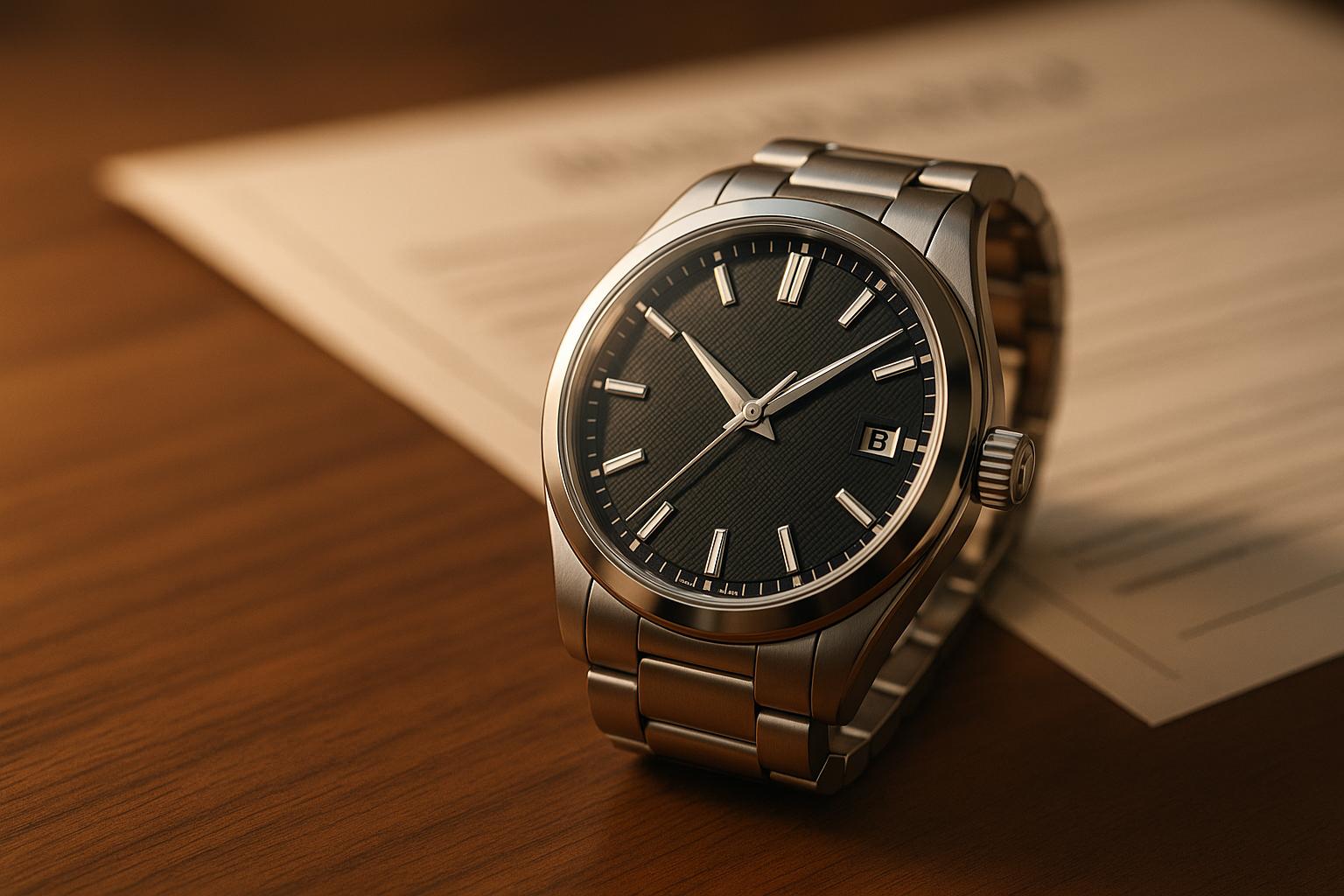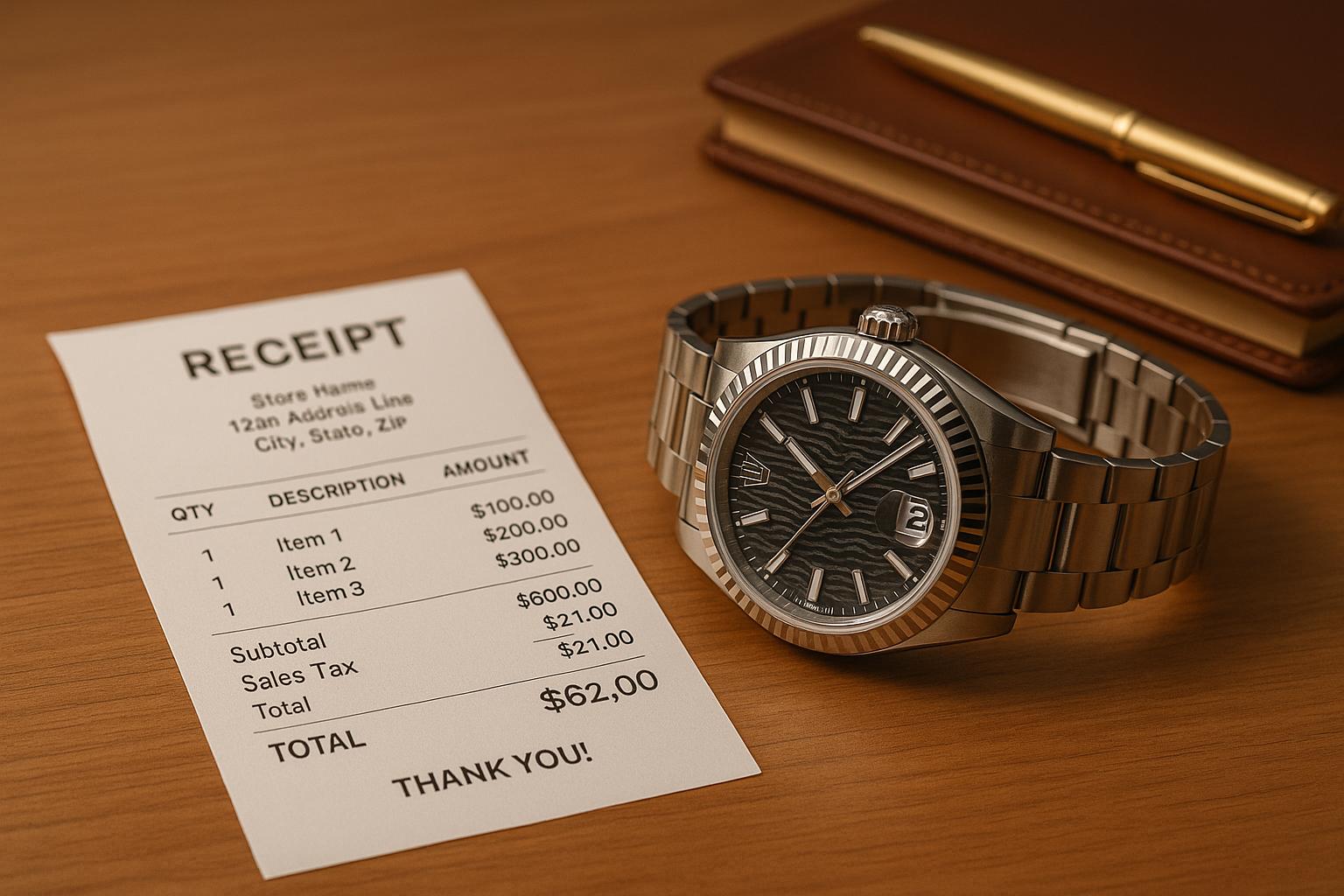Luxury watches are valuable investments, and protecting them with specialized insurance is crucial. Homeowners insurance often falls short, capping coverage at $2,500 for watches. Watch insurance fills this gap, offering protection against theft, loss, and damage. Here’s what you need to know:
- Theft Coverage: Applies when your watch is stolen (e.g., burglary, robbery). Requires a police report and proof of ownership. Costs 1–2% of the watch’s value annually.
- Loss Coverage: Covers accidental misplacement or mysterious disappearance. No police report is needed but requires proof of ownership and details of the incident. Costs are similar to theft coverage.
- Key Exclusions: Intentional acts, war-related damage, and negligence are not covered.
- Policy Costs: Vary by location and watch value. For example, insuring a $15,000 watch in Fort Lauderdale costs about $213/year.
To ensure smooth claims, keep receipts, appraisals, and photos of your watch. Regular appraisals (every two years) help maintain accurate coverage. Whether your watch is stolen or lost, having the right insurance policy ensures you’re financially protected.
Theft Coverage: When Your Watch Is Stolen
What Counts as Theft
Most insurance policies cover theft even if there’s no clear sign of forced entry. This typically includes burglary cases where evidence like a broken window, a tampered lock, or a damaged door shows someone gained access without permission.
How to File a Theft Claim
If your watch is stolen, the first step is to file a police report within 24 hours, detailing everything about the incident. Include when you noticed the watch was missing, where it happened, and any suspicious activity you observed. This report becomes crucial for your insurance claim, as it officially documents the theft.
Once the report is filed, notify your insurance company immediately. Most insurers require claims to be submitted within 30 to 90 days of the incident. Acting quickly can help speed up the process.
Prepare all the necessary documentation to support your claim. This includes the purchase receipt, appraisal, photos, warranty cards, and authenticity certificates. A detailed account of the incident – explaining where and when you last saw your watch and what happened – can also strengthen your case. Be ready to answer questions and keep a record of all communications with your insurer.
Theft Coverage Limits and Exclusions
Knowing the limits and exclusions of your policy can save you from unwelcome surprises. Most policies cover up to 100% of your watch’s appraised value, and some premium options may even extend to 125% to account for market value increases. For instance, if your $15,000 Rolex is stolen, you could receive the full replacement value – or even a bit more if the market value has risen since your last appraisal.
However, there are common exclusions to be aware of:
- Intentional Acts: Claims won’t be honored if the theft is found to involve a family member or someone close to you.
- Military Action or Acts of War: Incidents occurring during armed conflicts are usually not covered.
- Geographic Limitations: While many policies offer global coverage, some exclude high-risk regions.
The cost of theft coverage typically ranges from 1% to 2% of your watch’s appraised value annually. For example, insuring a $10,000 watch would cost around $100 to $200 per year. Some insurers may offer discounts if you use additional security measures, like a certified safe.
Regularly reviewing your policy ensures it reflects your watch’s current market value. This understanding of theft coverage lays the groundwork for comparing it with loss coverage.
Loss Coverage: When Your Watch Goes Missing
What Counts as Loss
Loss coverage kicks in when your watch disappears without clear evidence of theft. This could happen if it’s accidentally misplaced – like leaving it behind on a beach towel or in a public restroom – or if it mysteriously vanishes without explanation. In cases of mysterious disappearance, you might recall wearing the watch earlier in the day but later find it’s nowhere to be found. The good news? You won’t need a police report to file a claim for these situations.
How to File a Loss Claim
Once you realize your watch is missing, filing a loss claim is a straightforward process. Start by contacting your insurance provider immediately. Many insurers, like Chubb, offer 24/7 claim reporting through phone or online platforms, and Chubb aims to contact policyholders within six hours of receiving a claim.
When filing, you’ll need to provide a brief statement about the loss. For example, Jewelers Mutual asks for details about when and where you last had your watch and the circumstances under which it went missing.
To support your claim, gather proof of ownership. This could include your original purchase receipt, a recent appraisal, warranty cards, or dated photos of the watch. If you don’t have a receipt, a bank statement showing the purchase can often work as alternative evidence.
Loss Coverage Limits and Exclusions
Most specialized watch insurance policies provide coverage up to 100% of your watch’s appraised value, offering peace of mind that you’ll be compensated fully if it’s lost. However, it’s crucial to understand the exclusions that could lead to a denied claim.
For instance, negligence – like repeatedly leaving your watch unsecured – could void your coverage. Delays in reporting the loss may also jeopardize your claim. Additionally, voluntary separation of the watch isn’t covered. If you sell your watch and the buyer’s check bounces, or if you lend it to someone and they fail to return it, these scenarios fall outside the scope of loss coverage.
It’s also worth noting that homeowners insurance often caps watch coverage at $2,500.
The cost of loss coverage typically ranges between 1% and 2% of your watch’s appraised value. For example, insuring a $20,000 Patek Philippe might set you back $200 to $400 annually. To keep your policy up to date, regular appraisals are recommended to ensure your coverage reflects the current market value of your timepiece.
The Ultimate Guide to Insuring Your Luxury Watch
sbb-itb-fcc00bb
Theft vs. Loss: Coverage Comparison
When it comes to insuring your watch, theft and loss coverage serve different purposes, each tailored to specific scenarios.
Theft coverage kicks in when your watch is taken due to criminal acts like burglary, robbery, or pickpocketing. On the other hand, loss coverage applies when your watch goes missing without any indication of a crime, such as accidental misplacement.
Both types of coverage require timely notification to your insurer and supporting paperwork, such as receipts, appraisals, and photographs.
"Having the right paperwork ready can make a huge difference." – Q Report Team
Coverage Comparison Chart: Theft vs. Loss
| Aspect | Theft Coverage | Loss Coverage |
|---|---|---|
| Definition | Covers criminal acts like burglary, robbery, or pickpocketing | Covers situations where the watch is missing without evidence of theft |
| Police Report Required | Yes – a police report is usually mandatory | Typically not required |
| Documentation Needed | Police report, receipts, appraisals, photos | Receipts, appraisals, photos, and a detailed account of what happened |
| Coverage Limits | Up to 100% of the appraised value | Up to 100% of the appraised value |
| Common Exclusions | Excludes risks like war, intentional acts, or voluntary parting | Excludes intentional acts and wear-related deterioration |
| Claim Process | Notify your insurer promptly and provide all required documentation | Notify your insurer promptly with a detailed statement of the incident |
| Annual Cost | 1–2% of the watch’s value | 1–2% of the watch’s value |
This comparison highlights how each type of coverage plays a distinct role in safeguarding your investment.
Most watch insurance policies are considered "all perils" policies. This means they protect against a broad range of risks unless specifically excluded. Such comprehensive coverage often surpasses what standard homeowners insurance offers. For instance, homeowners policies typically cap watch coverage at $2,500 and may not cover situations where the cause of loss is unclear.
"Watch insurance is the best way to protect your luxury, high-end watches and watch collections. It safeguards you far beyond your watch warranty and often surpasses homeowners or renters insurance with higher coverage limits and more comprehensive protection." – Jewelers Mutual
How to Choose the Right Watch Insurance
When it comes to protecting your investment, selecting the right watch insurance is a critical step. The right policy ensures your timepiece is covered against potential risks while aligning with your budget and needs. Here’s what to consider when making your decision.
Checking Theft and Loss Coverage
A good policy should cover theft and loss, including "mysterious disappearance." Look for "all perils" coverage, which goes beyond the limits of standard homeowners insurance (often capped at $2,500 for watches). This type of coverage protects against a wide range of risks.
If you’re a frequent traveler, worldwide coverage is a must. Review the policy’s exclusions carefully – common exclusions might include damage from war, pest infestations, intentional acts, or natural wear and tear.
Another key feature to look for is whether the policy allows you to return to your preferred jeweler for repairs or replacement. Some policies even provide coverage beyond the insured value to account for fluctuations in the market, which is especially useful for luxury watches that may appreciate over time.
Finally, weigh the policy’s costs and deductibles to ensure they fit your financial situation and risk tolerance.
Policy Costs and Deductibles
The cost of watch insurance typically ranges between 1% and 2% of the appraised value of your watch per year. Factors like the watch’s value, your location, the level of coverage, and any security measures you have in place can influence the premium. Here’s a quick look at some examples:
- $65 annually for a $5,000 watch in Atlanta with a $0 deductible
- $95 annually for a $10,000 watch in Seattle with a $250 deductible
- $184 annually for a $12,000 watch in Chicago with a $100 deductible
- $213 annually for a $15,000 watch in Fort Lauderdale with a $500 deductible
- $284 annually for a $20,000 watch in Phoenix with a $500 deductible
Opting for a higher deductible can lower your premium, but make sure you’re comfortable with the out-of-pocket costs if you need to file a claim. Some insurers even offer $0 deductible options, which can provide additional peace of mind for a slightly higher premium.
Once you’ve chosen a policy, keeping thorough records will help ensure a smooth claims process.
Keeping Proper Records
Having organized documentation is essential when filing a claim. Before purchasing a policy, make sure to gather and maintain the following:
- Purchase receipt: This proves ownership and establishes the original value of your watch.
- Appraisal or valuation report: Get an official report that reflects your watch’s current market value. Update this at least every two years to ensure accuracy.
- Detailed photographs: Take clear pictures of your watch, including its condition, serial numbers, and any distinctive features.
Store digital copies of these documents securely, such as in cloud storage, so they’re safe even in the event of theft.
If your watch is stolen, file a police report immediately to substantiate your claim. For loss claims, you’ll need to provide a detailed explanation of what happened, even if a police report isn’t required.
Be prepared for insurers to request additional details or conduct interviews during the claim process. Having all your documentation in order from the beginning can make the experience much smoother.
Conclusion: Protecting Your Luxury Watches
Understanding the difference between theft and loss coverage is a key step in safeguarding your luxury watch collection. While both result in the disappearance of your timepiece, the way insurance companies handle these claims can vary significantly. Theft claims often require a police report and tend to be resolved more quickly. On the other hand, loss claims usually involve more detailed investigations and stricter documentation, making it essential to know what your policy covers.
Specialized watch insurance provides tailored protection that goes beyond the limitations of standard homeowners policies. Unlike homeowners insurance, which often has caps and exclusions, these specialized policies are designed to address the unique risks associated with luxury timepieces.
Keeping updated appraisals and detailed records is crucial for ensuring your watch is fully protected, especially under all-risk policies that cover mysterious disappearances. Whether your $15,000 Rolex is stolen from a hotel room or your vintage Omega vanishes during travel, the right insurance policy ensures you’ll be reimbursed for the full value. This level of protection is exactly what specialized watch insurance is built to deliver.
For collectors looking for expert guidance, Chronoexpert offers valuable insights on insuring, maintaining, and protecting your watches:
"At Chronoexpert, we understand the passion collectors have for their timepieces. Our mission is to help you protect, maintain, and enjoy your watches for years to come."
With reports showing 6,800 watches stolen in London last year, it’s clear that robust coverage isn’t just a luxury – it’s a necessity. Take the time to review your current insurance, update your appraisals, and secure a policy that truly reflects the value of your collection. Your watches are more than just accessories; they’re investments and treasures that deserve the right kind of protection.
FAQs
What’s the difference between theft and loss coverage for luxury watches, and how does it impact the claims process?
The key distinction between theft coverage and loss coverage comes down to how each situation is defined and the kind of documentation needed to file a claim.
Theft coverage kicks in when your watch is stolen – whether it happens at home, in public, or while traveling. To process a theft claim, you’ll typically need to provide proof, such as a police report, to confirm the event.
Loss coverage, on the other hand, applies when your watch is accidentally lost – like if you misplace it and can’t find it again. Filing a loss claim usually doesn’t require a police report, but you might need to show evidence that the loss was accidental.
These differences can influence both the time it takes to process your claim and the paperwork you need to prepare. Knowing how theft and loss coverage work is essential when selecting a watch insurance policy to ensure your luxury timepiece is safeguarded in every situation.
How can I make sure my watch insurance covers the current market value of my timepiece, and why does it matter?
To keep your watch insurance aligned with its current market value, it’s essential to update your policy regularly. Begin by having your watch appraised by a professional or using reliable watch valuation tools. Be sure to provide your insurer with the latest documentation, such as receipts, appraisals, or certificates for each of your timepieces.
This step is especially important because the value of luxury watches can shift over time. Without accurate coverage, you risk being underinsured, which could leave you with less compensation than your watch’s true worth in case of loss or theft. Taking these precautions helps ensure your investment remains properly protected.
What should I do right away if my watch is lost or stolen to make the insurance claim process easier?
If your watch is lost or stolen, taking swift action can help streamline the insurance claim process. Begin by filing a police report to create an official record of the incident. Next, notify your insurance company right away to report the loss or theft. Make sure to collect all relevant documents, including receipts, photographs, and proof of ownership, and follow your insurer’s guidelines for submitting the claim. Stay responsive to any follow-up requests from your insurance provider to prevent unnecessary delays.


